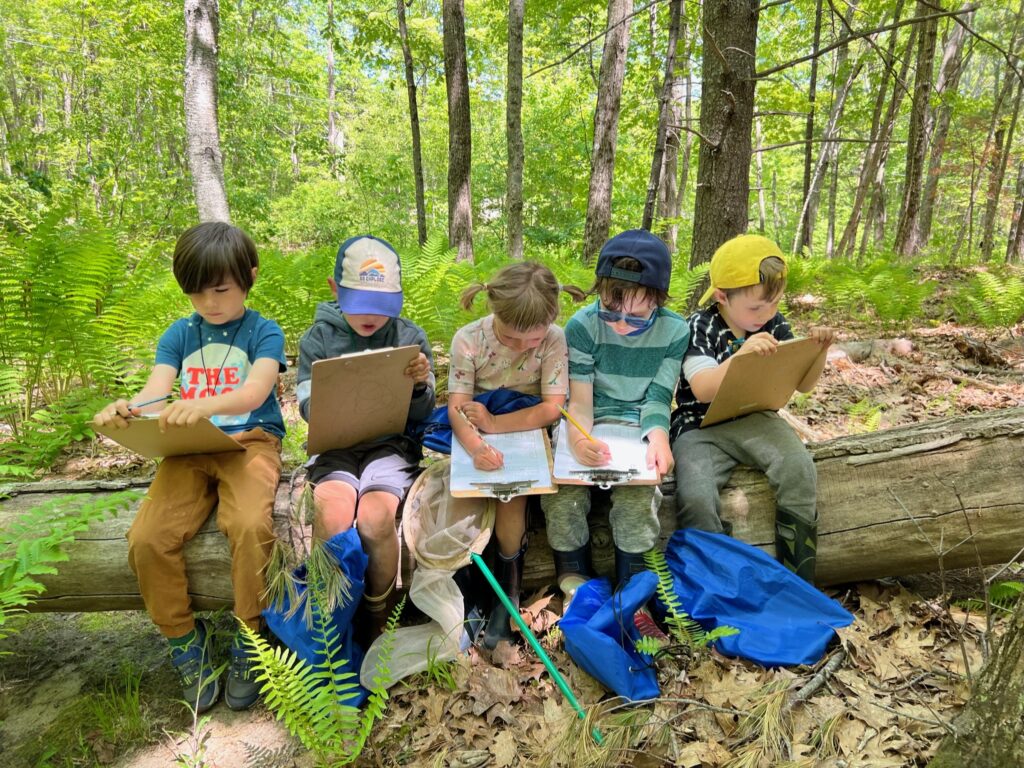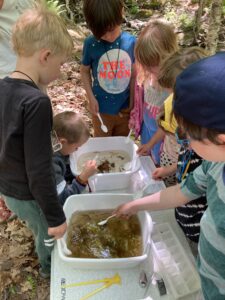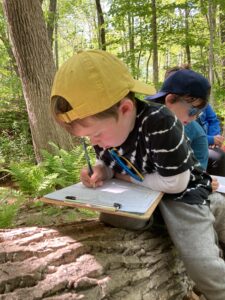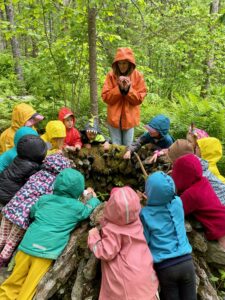
Late in May my class of seven kindergarteners at the Children’s House Montessori School set out to explore the stream at our satellite campus in Rockport. Our small school is located in downtown Camden but since fall 2020, we have spent each autumn and late spring in a 100% outdoor based setting with ample woods, stream, and ocean access. Yes, we know how lucky we are!
Initially a way to reduce risk associated with the COVID 19 pandemic, outdoor learning has become the cornerstone of our early childhood science curriculum. Montessori emphasizes hands-on learning and respect for the natural world, so it fits well with citizen science and the nature-school movement gaining popularity in the U.S. But our five- and six-year-olds don’t need to know any of this to know that playing in the woods and splashing in streams is just good, wet fun!
 I’ve wanted to sample our stream with my class for the past few years. I don’t know the actual name but we call it Curvy Creek. It is located right next to another favorite play space we named the Fern Forest. (Who doesn’t adore alliteration??) When a grant became available through S.E.A. (Stewardship Educational Alliance in Camden), I quickly reached out to the folks at the Stream Explorers program at Maine Audubon along with Maine Master Naturalist (and Montessori grandmother) Cathie Murray for help. Cathie and her husband Mike had come to my classroom in the winter to teach us about rocks, and I knew she would be an incredible resource and support. SEA provided the funds to purchase a special D-shaped kick-net specifically for macro sampling, along with a few other curriculum materials such as children’s books and cards for learning to identify the creatures and learn about their life cycles.
I’ve wanted to sample our stream with my class for the past few years. I don’t know the actual name but we call it Curvy Creek. It is located right next to another favorite play space we named the Fern Forest. (Who doesn’t adore alliteration??) When a grant became available through S.E.A. (Stewardship Educational Alliance in Camden), I quickly reached out to the folks at the Stream Explorers program at Maine Audubon along with Maine Master Naturalist (and Montessori grandmother) Cathie Murray for help. Cathie and her husband Mike had come to my classroom in the winter to teach us about rocks, and I knew she would be an incredible resource and support. SEA provided the funds to purchase a special D-shaped kick-net specifically for macro sampling, along with a few other curriculum materials such as children’s books and cards for learning to identify the creatures and learn about their life cycles.
For a week in class we read picture books about macro-invertebrates and discussed their role in determining stream health. I told the children that real scientists needed our help to see if our stream was clean or polluted. When Cathie arrived on a Tuesday afternoon, we were very ready and eager to see what we could find! Armed with dishpans, ice-cube trays, squirt bottles, nets, buckets, plastic spoons, pipettes, and tweezers, we set out with a sense of purpose; boots on feet and hand-lenses dangling from our necks.

Cathie showed us how to position our net just beyond a “riffle” (where the water flows quickly over rocks) and to lift the rocks in the streambed, rubbing them vigorously in the water as though washing them. Every child had an important job to do. Turning the net inside out in a bucket of stream water, we then poured our findings into the dishpans and let our eyes adjust to the “stream soup” of decomposing plant matter and algae. Within minutes the children were scooping out the larvae and nymphs, carefully placing them into ice cube trays with gleeful exclamations: “Caddisfly! Mayfly! Stonefly! OH MY!!”
Our biggest surprise—and the find that sparked the most curiosity—were several huge segmented worms about three inches long that squirmed quickly through the water resulting in peals of fascinated shrieks. No one in our group had ever seen anything like this before. Cathie used the iNaturalist app, which mistakenly suggested that they were sea slugs. Though a neat idea, we knew this was unlikely. Using invented spelling, (“SES LUG”) the children wrote it in their field notes anyway.
 Once home, Cathie consulted a friend and we learned they were actually Giant Cranefly larvae! So cool! A couple of days later some of the kids were delighted to find a very large adult cranefly on our school porch, excitedly calling friends over to see, watching captivated for several minutes.
Once home, Cathie consulted a friend and we learned they were actually Giant Cranefly larvae! So cool! A couple of days later some of the kids were delighted to find a very large adult cranefly on our school porch, excitedly calling friends over to see, watching captivated for several minutes.
In spite of the fact that our group was the youngest ever to participate in Stream Explorers, Maine Audubon’s Hannah Young, who has a preschooler of her own, encouraged me to give it a try. I’m so glad we did. Our students had the most amazing time learning about aquatic insects and discovering that our stream is very healthy indeed. I’m certain they will never forget the crazy critters they found at Curvy Creek.

Suggested Reading List for Kindergarten-Third Grade Students
The Secret Stream by Kimberly Ridley (terrific book with gorgeous illustrations of aquatic insects)
Creek Critters by Jennifer Keats Curtis with Stroud Water Research Center
(a brother and sister sample a stream for macroinvertebrates)
MAC, the Macroinvertebrate by Chuck Dinkle with Trout in the Classroom Program
Trout Are Made of Trees by April Pulley Sayre (great book about the cycle of stream life and interdependence)
